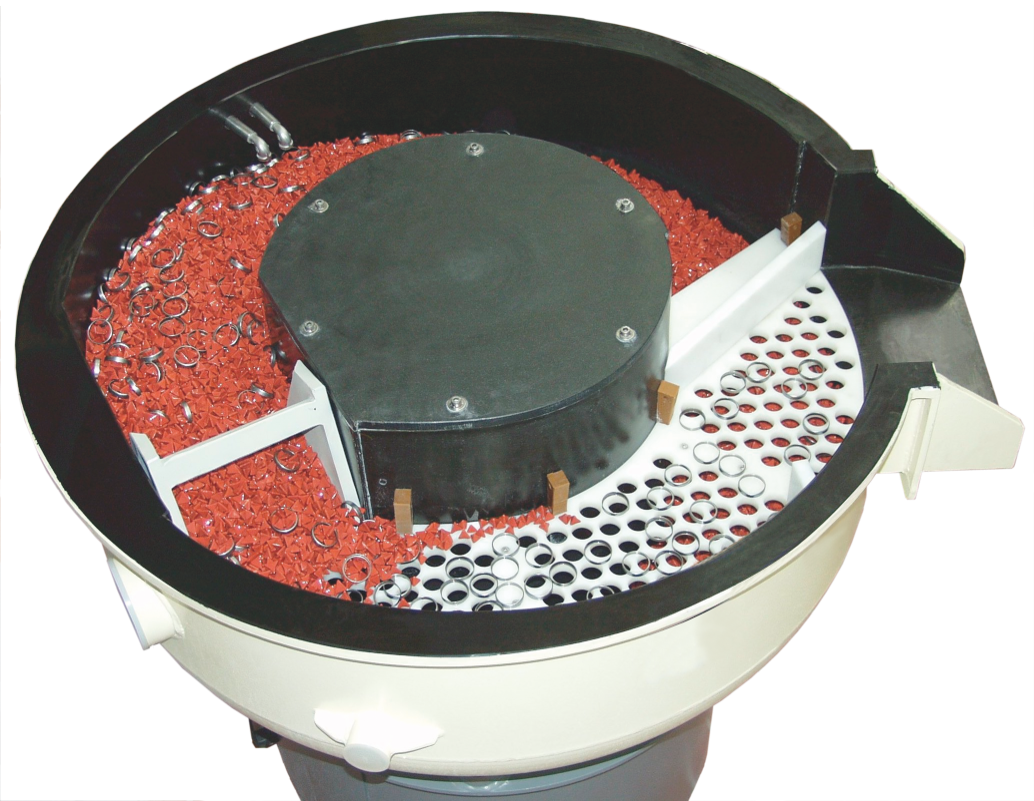
Mass Finishing Work Piece Handling Series, Part 1 – Selecting the Best Work Piece/Media Separation Method
, sramaker - Назад к обзору
One of the first considerations in finishing process development is the ability to effectively separate mass finishing media from the work pieces. If separation cannot be achieved, the process will not be viable. Signs of inadequate separation may include the need for too much manual intervention, lodged media causing downstream process issues, failure to meet finishing standards, or even product recalls.
For processes that do not require work pieces to be firmly mounted to fixtures in the machine, components and media loosely tumble in mass finishing processing bowls and troughs to achieve the desired finishing result. While this interaction is encouraged during processing, swift and precise media separation is crucial before work pieces move onto the next process step.
Rosler has more than 80 years of experience designing mass finishing machines and supplying consumables. Our expertise can help develop the best separation method and settings for your unique combination of finishing, work pieces, and media.
Separation Objectives
If not properly removed from work pieces, media carried out of the machine can cause disastrous results in automated, downstream manufacturing operations such as machining, assembly, painting, etc. The manner in which media and work pieces are separated matters as well.
The separation stage must not be too aggressive, as it could damage the finished work pieces with nicking and scratching if not carefully calibrated.
Media and work pieces exit the machine outlet and pass over a polyethylene screen with round holes for external separation
Separation must also take place in the shortest possible time to avoid costly extensions of the overall cycle time.
The separation process should not require any support by the machine operator such as manually holding back the media/work piece mix on the separation screen.
Separation Speeds
While all machine types must meet the aforementioned separation objectives, some types require extra adjustments for vibratory motor speeds to aid the separation process within the machine.
Where possible, separation is done in the finishing machine. This reduces the need for media handling, as the media remains in the machine and the parts are separated via built-in separation screens. Reducing the machine speed in rotary vibrators, long radius machines, and vibratory dryers after the higher intensity processing cycle provides more effective separation and minimizes part-on-part damage during the parts unloading step.
Rosler rotary vibrator with internal separation screen
Machines that require unloading the media/part mix from the machine at the end of the finishing process usually use external screening systems to separate the parts from the media. The external screening system has its own vibratory drive system that can be set and adjusted to maximize the screening speed while providing gentle part transportation.
Rosler rotary vibrator with internal separation screen
In either case, it is very important to select the correct screen type and hole size. Holes that are too small may cause media carry‐out while holes that are too large might cause work pieces to lodge in the screen or even fall back into the machine. The screen deck length must also be carefully considered.
Methods of Separation
In mass finishing, screen and magnetic methods of separation are most common.
Separation Screens
Available in a wide selection of hole sizes and shapes, separation screens are made of a variety of materials.
Screen types include (top, from left) polyethylene screens with round or oblong holes, (middle) wire mesh screens coated with polyurethane or made from steel, and (bottom) bar screens made from steel or polyethylene
Rosler offers numerous screen options, including:
- Polyethylene screens with round or oblong holes.
- Wire mesh screens coated with polyurethane or made from steel.
- Bar screens made from steel or polyethylene.
Magnetic Separators
When screen separation is difficult or even impossible, magnetic separators are a good alternative. For example, when the work pieces and the media have a similar shape or are the same size, magnetic separation is an excellent option.
The use of magnetic separators requires that work pieces are ferrous and attracted by a magnet.
These systems can be configured with a drum or belt as well as demagnetizing zones.
Rosler magnetic drum separator
Rosler magnetic belt separator
Updates for Existing Systems
Consult with your supplier to learn about the available separation options for the mass finishing machine you are using or intend to use.
Available equipment updates may include:
- Frequency inverters enabling you to vary the motor’s speed. Most vibratory motors run at two speeds; namely 1,800 RPM (4‐pole mode) or 1,200 (6‐pole mode) by default.
- Installation of different screens utilizing different materials and hole sizes and shapes.
- Magnetic drum or belt separators.
Regardless of the upgrade, ask your supplier to run a test processing trial before installation to ensure the change is satisfactory. Rosler offers free testing in our global Customer Experience Centers.
The Rosler Way
Decades of experience and ability to design, service, and maintain machines as well as the consumables and accessories to get the finish you require make Rosler a well-rounded surface finishing expert. Contact us to discuss your mass finishing and work piece handling needs.
The complete Mass Finishing Work Piece Series includes:






